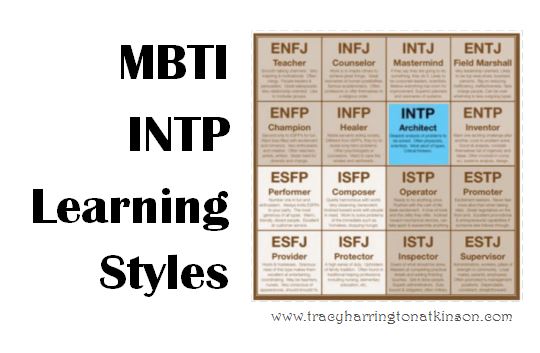INTP (Introversion, Intuition, Thinking, Perceiving) Learning Style
Seek to develop logical explanations for everything that interests them. Theoretical and abstract, interested more in ideas than in social interaction. Quiet, contained, flexible, and adaptable. Have unusual ability to focus in depth to solve problems in their area of interest. Skeptical, sometimes critical, always analytical.
~Excerpted from Introduction to Type®
by Isabel Briggs Myers
 ____________________________________________
____________________________________________
Frequency
| INTP – | 3.3% of the total population |
| 4.8% of the male population | |
| 1.8% of the female population |
| Introversion (I) | 50.7% of the total population |
| Intuition (N) | 26.7% of the total population |
| Thinking (T) | 40.2% of the total population |
| Perceiving (P) | 45.9% of the total population |
_______________________________________________
The estimated frequency table was compiled from a variety of MBTI® results from 1972 through 2002, including data banks at the Center for Applications of Psychological Type; CPP, Inc; and Stanford Research Institute (SRI).
Learner Keyword: analytical and critical1
Learner Question
INTPs, while learning, address the question, “How is this structured?”2
Learning Style
INTPs can easily comprehend complicated and complex information. They can also easily assimilate practical information as well as conceptual knowledge. They search for theories to learn. They prefer deep, analytical information and swiftly make connections between real-world applications and classroom knowledge
INTPs are logical and analytical thinkers who enjoy solving problems. They like to research and enjoy learning. They enjoy demonstrating what they know and their competence which they achieve through asking questions to complete their understanding.
INTPs are problem solvers. They are stimulated by ideas, particularly focusing on abstract applications and patterns which may cause them to overlook some details.
Subscribe to our YouTube Channel by clicking here.
Cognitive Environment
INTPs work well in a flexible, unstructured learning environment although they do have a preference for independent study which is characteristics of most introverts. The prefer some general outlines for learning.
INTPs are especially gifted learners in cognitive environments which promote experimentation, inquiry and questioning. They enjoy assignments and tasks which are innovative and original.
INTPs prefer working alone but can work in small groups. They are interested in discussion and brainstorming.

For other learning styles: MBTI Learning Styles – A Practical Approach Available in paperback; Kindle; and pdf versions
INTPs are most comfortable:
- Learning theories
- Independent work
- Reading
- Reflecting
- Noticing and making connections between patterns
- Creativity and inspiration
- Solving new problems and having new opportunities
- Listening and observing
- Brainstorming and generating ideas
- Unstructured learning environments
INTPs are least comfortable:
- Structured learning environments which stifles creativity and originality
- Routines and repetition
- Summarizing
- Step by step instructions which leaves no room for imagination
- Details
- Being the center of attention
- Too much focus on details, facts and figures
Learn More:
For more information on teacher and classroom tips, learner tips, instructional strategies and assessment strategies, see MBTI Learning Styles: A Practical Approach or learn more on Udemy.
Click on one of the sixteen personality types for more information:
Click on one of these dimension for more information:
For other learning styles: MBTI Learning Styles – A Practical Approach Available
References
Bonwell, C. & Eison, J. (1991). Active Learning: Creating Excitement in the Classroom. ERIC Digest. ERIC Clearinghouse on Higher Education, Washington, D.C
Career Assessment. (2017). The 16 Myers-Briggs Type Indicator Personality Types (MBTI personality types). Retrieved from: http://careerassessmentsite.com/tests/myers-briggs-tests/about-the-myers-briggs-type-indicator/the-16-myers-briggs-personality-types/
CPP, Inc. (2017). Linking MBTI® Personality Type to Learning Style – Strategies and Insights. Retrieved from: http://www.cppblogcentral.com/cpp-connect/linking-mbti-personality-type-to-learning-style-strategies-and-insights/
Defiance College. (2106). What’s Your Personality Type? Retrieved from: http://library.defiance.edu/learningstyles/myersbriggs
Gregory, G. (2008). Differentiated instructional strategies in practice: training, implementation, and supervision (2nd ed.). Thousand Oaks, CA: Corwin Press. p. 97-99.
Humanmetrics. (2017). Learning Styles. Retrieved from: http://www.humanmetrics.com/personality/learning-styles
Kiser, H. (2017). Choice board. Retrieved from: https://hillarykiser.blogspot.com/2012/10/choice-board.html?showComment=1491939410939#c9063789945839625994
Krafka, K. (2017) Learning Menus. Retrieved from: http://prescriptionforgiftedsuccess.weebly.com/learning-menus.html
Litemind. (2017). What is mind mapping? Retrieved from: https://litemind.com/what-is-mind-mapping/
Martinez, M. (2006). What is metacognition. Phi Delta Kappan, 64(10), 696-699.
Melvin, J. (2017). Personality Type as an Indicator of Learning Style. University of Rochester. Retrieved from: file:///C:/Users/Tracy/Downloads/JMelvinSGf13paper%20(2).pdf
Myers & Briggs Foundation. (2017). How frequent is my type? Retrieved from: http://www.myersbriggs.org/my-mbti-personality-type/my-mbti-results/how-frequent-is-my-type.htm
Myers & Briggs Foundation. (2017). Type and Learning. Retrieved from: http://www.myersbriggs.org/type-use-for-everyday-life/type-and-learning/
Myers, I. (1998). Introduction to Type: A Guide to Understanding Your Results on the MBTI Instrument. Consulting Psychologists Press.
Myers, I., McCaulley, M., Quenk, N. & Hammer, A. (2009). MBTI Manual: A Guide to the Development and Use of the Myers-Briggs Type Indicator Instrument. Consulting Psychologists Press.
Okoro, C. & Chukwudi, E. K. (2011). Metacognitive skills: A viable tool for self-directed learning. Journal of Educational and Social Research, 1(4), 71-76.
Pelley, J.W. (2008). The Success Types Learning Style Type Indicator. Retrieved from: Texas Tech University. https://www.ttuhsc.edu/som/success/lsti.aspx
Smith, C. V. & Cardaciotto, L. (2011). Is active learning like broccoli? Student perceptions of active learning in large lecture classes. Journal of the Scholarship of Teaching and Learning, 11(1), 53-61.
University of Texas. (2017). Experiential Learning. Retrieved from: https://facultyinnovate.utexas.edu/teaching/strategies/overview/experiential-learning
Western Nevada College. (2017). Personality Types and Learning. Retrieved from: http://www.wnc.edu/mbti/personality-types/

Comments are closed